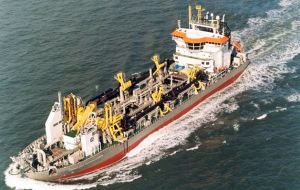MercoPress. South Atlantic News Agency
Dutch dredger operating in Tierra del Fuego bunkers in Falklands
 Trailing suction hopper dredger Prins der Nederlanden
Trailing suction hopper dredger Prins der Nederlanden An unusual visitor to the Falkland Islands last week was the Prins der Nederlanden, which anchored in Port William for the second time to receive fuel, reports the local Penguin News.
The Prins der Nederlanden was built in 2004 and is a trailing suction hopper dredger with an overall length of 156 meters and gross tonnage of 18,091 tons.
The vessel has been undertaking dredging works between Tierra de Fuego and mainland Argentina, preparing a trench for a gas pipeline. Agency services to the vessel during both visits were performed by Stanley Services Limited.
Last November 15, Argentina’s state news agency Telam reported that construction had begun on a new 38 kilometres sub-sea gas pipeline to double the supply capacity from Tierra del Fuego to the mainland.
The new pipeline, which will link up with the national trunk-line system, will help to connect gas-fields offshore Tierra del Fuego to large domestic markets further north, stimulating exploration and production in the southernmost province.
The new pipeline will run parallel to an existing 30-year-old sub-sea link, connecting Cape Espíritu Santo in the Argentine section of Tierra del Fuego to Cape Vírgenes in the mainland province of Santa Cruz.
The pipeline is expected to add 6.2bn cubic metres (bcm) of carrying capacity, doubling Tierra del Fuego's current maximum send-out volumes.
The project is being carried out on behalf of the government by a joint venture (JV) between Dutch firm Royal Boskalis Westminster and Swiss-based Allseas Group at a cost of US$265mn, according to industry news provider Platts.
Argentina's planning minister Julio de Vido expects the new pipeline on-stream in February-March 2010.
The Argentine government is hoping the new generation of fields in the south will help to offset falling gas output from the mature basins in the west and north-west of the country. Particularly high hopes have been placed on offshore acreage, although deepwater exploration in Argentina has so far failed to take off the ground in a major way owing to the financial crisis and regulatory uncertainty. According to government data, Tierra del Fuego already produces around 4.6bcm of gas per annum, mostly from the Carina and Aires shallow-water fields, which are run by a consortium comprising French major Total, Germany's Wintershall and Pan American Energy (itself a JV between BP and local company Bridas). The national gas regulator Ente Nacional Regulador del Gas (ENARGAS) is hoping that by expanding pipeline connections from Tierra del Fuego, more upstream players will enter the remote region. (PN, Business Monitor International, Royal Boskalis Westminster).-




Top Comments
Disclaimer & comment rules-

-

-

Read all commentsMalvinas are part of Tierra del Fuego, Antarctica & South Atlantic Islands Province. The Capital: Ushuaia City.
Dec 29th, 2009 - 08:10 am 0Nitrojuan.
Dec 29th, 2009 - 12:23 pm 0In our part of the world(Scandinavia/Denmark) we still call the islands Falkland Islands as we allways have done.
Why dont you try to be realistic????
If the rest of the worlds nations suddenly wanted to regain former borders what would happen??
Italy would want Roman Empire borders .France would like borders from the great time of Napoleon. Germany would like to have borders from 1938 and etc....
Fortunately UN realised ,that if such old claims could be requested and accepted, the whole world soon would be in fire and flames, and cleverly the refused. The claims were even from a time befor UN existed.
I know it is difficult.. but try to be realistic... We live in XXl century...
If you live in that part of the world why don't you get into your own bussinesses!
Dec 31st, 2009 - 08:31 pm 0You have in europe too many things to be worried about instead of talking nonesenses in a mercosur and south atlantic site!
We know what we have to do. We are not children.
Hppy new year!!!!
Commenting for this story is now closed.
If you have a Facebook account, become a fan and comment on our Facebook Page!